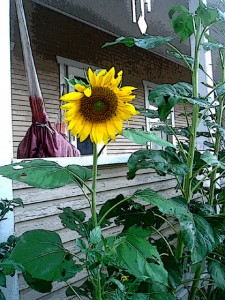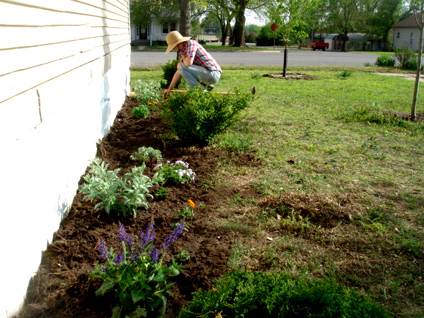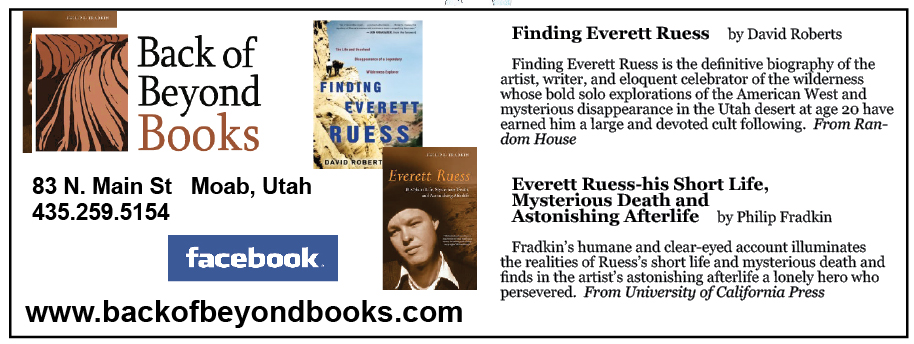What We Found, Searching for ‘The Way Life Should Be’
By Tonya Morton
This was the week of the County Fair—big news in our tiny town of under a thousand people. People arrived at the high school, braving heat of over a hundred degrees, to compare bushels of wheat, cut flowers, artwork and various fruits and vegetables. And the rest of us wandered through the aisles of displayed work, commenting on a particularly fine cucumber or a surprisingly large squash. Nearly all the children’s entries bore a 4-H mark, meaning these were kids who spent their extra time working with cattle or horses, learning to grow crops, and generally preparing for a life of hard work on their parents’ ranches. The adult entries—quilts, plants, artwork—were each meticulously created, bearing testament to the care and attention required of ranch life. The lady selling baked goods, most for less than a dollar apiece, asked how Jim and I were faring in the heat. “It’s a wonder people still manage to come out in such a summer,” she said, handing me my change. A neighbor waved hello from the corner and, walking over, asked Jim whether we’d be attending the animal exhibits the next day.
I was raised in South Dakota and so I like to think I’m well-acquainted with a rural atmosphere; but still I struggled to  hide my wonder. How could this scene exist in the same world as Lady Gaga and Donald Trump and the iphone? How is it that some places still seem innocent? With only a few minor changes, we could have been attending the fair held by our neighbor’s parents and grandparents. Of course, no place is fully innocent. It’s true, this area is incredibly unique in its number of small farmers and ranchers—rural people who can still tell you who owned which bank in the 1930s, and who was stingy with loans during the Dust Bowl. It’s true that an older gentleman seated next to Jim at a barbeque recently could describe for us his fear, as a child, watching blankets of dust enveloping his parents’ ranch. And it’s true, of course, that everyone in town knows more about our house than we do. One night, a grizzled man stopped us in the local pizza joint to ask what we thought of the wood stain he’d put on our floors. The kindhearted local judge stopped by one afternoon to say hi and mentioned that, forty years earlier, he had worked on our roof. And, most interestingly, our neighbor’s grandchildren wanted to know if we’d encountered “the Grey Lady,” a ghost who walks through our attic at night—or so their parents had told them.
hide my wonder. How could this scene exist in the same world as Lady Gaga and Donald Trump and the iphone? How is it that some places still seem innocent? With only a few minor changes, we could have been attending the fair held by our neighbor’s parents and grandparents. Of course, no place is fully innocent. It’s true, this area is incredibly unique in its number of small farmers and ranchers—rural people who can still tell you who owned which bank in the 1930s, and who was stingy with loans during the Dust Bowl. It’s true that an older gentleman seated next to Jim at a barbeque recently could describe for us his fear, as a child, watching blankets of dust enveloping his parents’ ranch. And it’s true, of course, that everyone in town knows more about our house than we do. One night, a grizzled man stopped us in the local pizza joint to ask what we thought of the wood stain he’d put on our floors. The kindhearted local judge stopped by one afternoon to say hi and mentioned that, forty years earlier, he had worked on our roof. And, most interestingly, our neighbor’s grandchildren wanted to know if we’d encountered “the Grey Lady,” a ghost who walks through our attic at night—or so their parents had told them.
But the problems of modern American existence aren’t kept so easily at bay. The kids here listen to the same awful music and watch the same horrible movies as their urban counterparts. Quite a few people have smartphones and almost everyone has joined Facebook. And when we eat tomatoes, even in the midst of farmland, they were most likely grown in the sand of Florida.
——–
The first few days of our new life on the Great Plains, one year ago, were excruciatingly hot, but also exciting, as we wandered through the old house and around its exterior. For the most part, the lot was a blank canvas. A few big Elm trees shaded the Eastern side; a large Cottonwood sat at the front of the house, facing the South; but, on the West, which needed the most shelter from the blazing afternoon sun, only a fledgling willow tree baked in the heat, the light filtering through its spare branches with little obstruction. We knew a few perennial flowers would be popping up in the spring, thanks to the Real Estate pictures, but, in August, after a brutal summer, only a single patch of Sedum stood to the East of the front door. We had backbreaking work ahead of us, we knew, but that was why we had come here.
First, we planted trees. We planted six in the fall. Two Bartlett Pears, two Red Maple, and two Oklahoma Redbuds. And we used the winter to plan. Our neighbors must have found us hilarious; as we stood, arms wide, across from each other, we mentally planted tomatoes and peppers and spinach and pumpkins. We stared at the West entrance to the house, and mapped out perennial beds. We stared at the East side and we imagined herbs growing under the kitchen window. I spent hours daydreaming about my mother’s gardens from my childhood home in South Dakota and searched out half-forgotten memories of bee balm, yarrow, coneflowers, black-eyed susans, asters and Sweet William. When March came, I grew seeds in our living room windows; marigolds, sunflowers, black-eyed susans and purple coneflowers in one; lavender and mint in the other.
In April, we prepared the ground and we waited for the danger of frost to pass. In May, we planted. As we began to appreciate the full measure of the work facing us, we edited our plans a bit—no big vegetable garden this summer; no hedges yet. Still, another Maple tree and a Sycamore found places in the Western yard. And all the plants from the living room windows went into the ground. In a matter of two weeks, we planted hydrangeas, roses, meadow sage, sedums, hyssop, and yarrow. Our neighbors drove by and honked at our progress. We waved back, covered in dirt and sweat. All the flowers began establishing themselves and the trees sprouted new leaves each day, but our biggest gamble remained unsure—the small patch of land we’d set aside for our future vegetable garden, limited this first year to tomatoes and peppers.
In mid-June, a single green pepper appeared. But the damaging winds our state is famous for swept in one evening and, the next morning, the tiny pepper had fallen. A week or two later, three tomatoes erupted from one plant. Each day they plumped a bit more. But then the heat set in. Every day over a hundred degrees. Even with extra water, the tomato plants stalled—unwilling to produce fruit under such inhospitable conditions.
And so our dreams of a kitchen garden faltered a bit. I put away my books on do-it-yourself canning and our talk turned to next summer and how many pumpkins and how much spinach. And we went to the fair this week and examined the county’s largest squash. Looking around at the children’s entries, poems about the cowboy life and drawings of horses, I wondered whether these children would be allowed to live the way their parents and grandparents had. This place had held out against the “modern life” for so long, but how much longer could it hold? The persuasive pull of agribusiness and the cash cow of wind farms and natural gas fracking had already introduced themselves into the area. If these are allowed to continue, what joy will remain in that rural child’s life fifty years from now? And, feeling a little silly, I wondered, how would a tiny vegetable garden in our back yard accomplish anything, faced with the death of an entire way of living? Here we were, two interlopers from tourist West, looking to this tiny community to find a more honest way of living. In the meantime, our town is in the fight of its life, trying to preserve its sweetness and simplicity in the face of the larger world.
The only conclusion I could draw: there’s no bringing back the life that has died. And our little garden will never  accomplish much of anything, other than hopefully bringing a little more health into our diets and some beauty to the house. But if our neighbors are still willing to withstand drought and day-after-day scorching heat just to compete for the honor of having grown the largest squash in the county, then I can’t say all is lost. Maybe a small town’s love of honesty and simplicity will be enough to sustain it for a few more generations. All we can do is raise a little flag of vulnerable hope on the prairie, that there still may be value in the rural life.
accomplish much of anything, other than hopefully bringing a little more health into our diets and some beauty to the house. But if our neighbors are still willing to withstand drought and day-after-day scorching heat just to compete for the honor of having grown the largest squash in the county, then I can’t say all is lost. Maybe a small town’s love of honesty and simplicity will be enough to sustain it for a few more generations. All we can do is raise a little flag of vulnerable hope on the prairie, that there still may be value in the rural life.
Tonya Morton is a regular contributor to The Zephyr. Her next byline will be as Tonya Stiles.
To read this article in PDF form, click here: aug11-6-7
Don’t forget the Zephyr Ads! All links are hot!



hi Tonya! Congratulations on snagging Jim–just read your piece, sounds like you moved him out of Monticello. If you dare, send me your snail-mail address and then I can send you Evan Cantor Holiday Art cards at Christmas. I don’t think I ever had Jim on my list for art cards… that’s too bad, too, ‘cuz he’s done more than most to deserve a few art cards every now and then. I’m hangin’ in there, feelin’ fine, say hello to Jim for me. Thanks, Evan